Abstract
Background:
Bibliometric analysis is an approach to evaluate the circumstances and trends in specific research field over time and to provide inspiration in future research and policy. Researches have a tremendous increase focus on the role of the microbiota in the development of diabetes in recent years; however, there is no published literature conducting a bibliometric analysis to explore the tendency. The aim of this study was to provide a detailed evaluation of the hundred most cited articles in microbiota of diabetes research.
Methods:
The database of the Web of Science was utilized for identification of articles. The top 100 were selected for further analysis of authorship, number of citations, article type, source journal, geographic origin, and interactions.
Results:
The articles selected were published from 2007 to 2015. The total citations ranged from 1289 to 35, citation density ranged from 163.75 to 6.5. The article type included basic science (n = 32), review (n = 29), expert opinion (n = 19), cross-sectional study (n = 12), RCT (n = 3), and others (n = 5). The study content included pathogenesis (n = 58), risk factor (n = 11), modifying of intestinal microbiota (n = 10), prebiotic treatment (n = 8), antibiotic treatment (n = 4), diet control (n = 4), and others (n = 5). The 100 most cited articles were published in 59 journals. Among them, Diabetes (n = 7), Diabetologia (n = 7), and Plos one (n = 7) published the most T100 articles. In total, 24 countries and 174 scientific research institutions participated in those researches. USA (n = 32) and Belgium (n = 22) were the leading countries in this field, followed by France (n = 18) and Finland (n = 16). Patrice D. Cani contributed the most top cited articles (n = 15).
Conclusion:
This bibliometric study is likely to include a list of intellectual milestones focused on microbiota of diabetes research in the past decade, which provides insights into the circumstances and trends in preventing and treating diabetes from a new perspective.
Keywords: academic influence, bibliometric analysis, diabetes, microbiota, Web of Science
1. Introduction
Diabetes mellitus (DM) has become an important public health problem worldwide.[1,2] However, the glucose control was not satisfying.[3,4] It is urging to expand the mechanism exploration and develop strategies of treatment. Scholars found that the microbial ecology in humans could be an important factor affecting energy homeostasis.[5,6] Numbers of researches have confirmed the important mechanism and demonstrated that it was useful to regulate gut microbiota for controlling metabolic disorders.[7,8]
Bibliometric analysis represents a snapshot that provides a cross-sectional view of the current state of the topic.[9] It is statistical and quantitative analysis with the aim of analyzing the scholarly impact and characteristics of publications within a specific research field, which could provide useful information to scientists involved in the development of research strategies to address health issues. Scholars have investigated the most cited articles that describe the advances in varies specialties and subspecialties included diabetes research,[10–13] which helped recognizing the quality of the works, discoveries, and the trends steering the study.[14,15] As numbers of literatures and researches reported that the microbiota was the important mechanism to influence the diabetes pathogenesis, there is a need to conduct a bibliometric study on the published literature relating to microbiota of diabetes to investigate the important mechanism of this disease reflected in trends.
Thus, the aim of this study was to provide a detailed evaluation of the hundred most cited articles in microbiota of diabetes research using bibliometric analysis, hoped to get the insights of microbiota of diabetes by analyzing the authorship, number of citations, h-index, citation density, source journal, geographic origin and interactions, scientific research institution, article type, and funding source.
2. Materials and methods
The Web of Science database was used to identify the top articles concerning microbiota of diabetes from the beginning of the database to August 12, 2016. Microbiota and diabetes were used as search term. Around 100 most cited articles were obtained and reviewed.
Every identified article was evaluated to guarantee that microbiota of diabetes was the major subject of the research, regardless of the article type and language. Researches focused on microbiota of diabetes complicated with other diseases such as obesity and metabolic syndrome were included as well. This research is literature analysis, which involved published studies. Hence, the ethical approval is waived.
The publication information and bibliometric indicators were collected from those included articles: (1) publication information, including authorship, source journal, year of publication, geographic origin, and scientific research institution; (2) study contents, including article type, main subjects of study, and funding source; (3) Bibliometric indicators, including number of citations, citation density and h-index. Citation density which defined as citations per year after publication was calculated.
3. Results
The total citations of T100 varied from 1289 to 35, mean citations per article was 160.25. 8 articles had citations over 500, more than half of the articles (n = 56) received < 100 citations. The citation density varied from 163.75 to 6.5, with the mean density of 34.27. The correlation between total citations and citation density is significantly strong (Pearson's correlation coefficient = 0.860, P = .00). Articles with higher citation density tend to have more total citations in T100. H-index of each article was obtained in WOS. It varied from 93 to 2, with the mean of 22.68. The correlation between h-index and total citations were also significantly strong (Pearson's correlation coefficient = 0.918, P = .00).
All the articles selected were published after 2007, suggesting that this field has become the scholars’ focus in the past decade. Most of the T100 were published in 2010–2013 (n = 77). The most-cited article (n = 1289) was published in 2007 on Diabetes by Patrice D. Cani in Belgium, who contributed the most to the T100 articles (n = 15). It was a basic science to explore the mechanism of how gut microbiota modulated by fat food content and triggered the metabolic diseases.[16] However, the highest citation density article was published in 2012, with mean 163.75 citations per year. It is a cross-sectional study for sequencing of the gut microbial DNA from 345 Chinese individuals and identifying the gut microbial markers that might classify T2DM, published in Nature by Junjie Qin and Jun Wang in China.[17]
The T100 were published in 59 journals, leaded by Diabetes (n = 7), Diabetologia (n = 7), PLoS One (n = 7), Cell (n = 5), Nature (n = 5), and Gut (n = 5), most of them are the top journal in medical and diabetes.
The article types of T100 divided into basic science, case-control study, cross-sectional study, prospective-cohort study, randomized clinical trial (RCT), review and expert opinion. However, there is neither guideline nor meta-analysis study yet. Basic science and review contributed the largest proportion of T100 (32 and 29 articles respectively), followed by expert opinion (n = 19). Figure 1 showed the distribution of T100 article types by year of publication.
Figure 1.
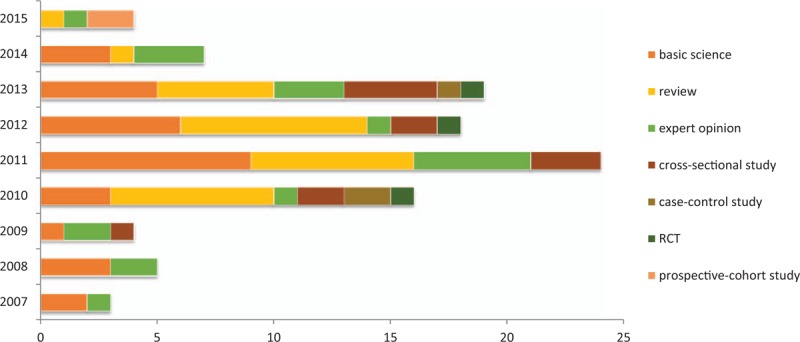
Distribution of article type in T100 divided by year.
The study contents of T100 could be categorized into pathogenesis, risk factor, treating by antibiotic, diet, metformin, modifying of intestinal microbiota, prebiotic, Roux-en-Y gastric bypass (RYGB), short-chain fatty acids (SCFA), and traditional Chinese medicine (TCM). Pathogenesis took the largest proportion of the T100 articles (n = 58), followed by the risk factor (n = 11) and modifying of intestinal microbiota (n = 10). Figure 2 showed the distribution of T100 study contents by year of publication.
Figure 2.
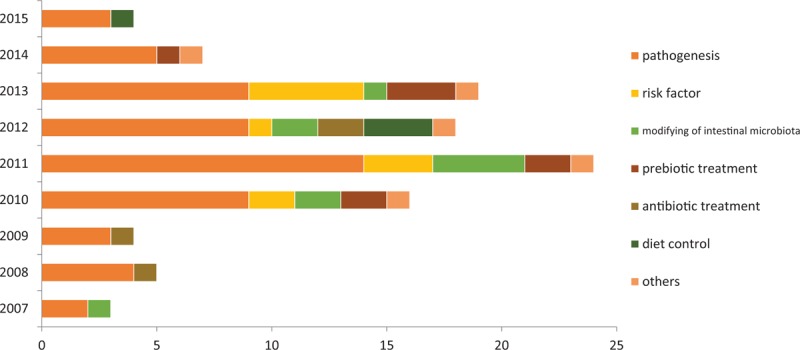
Distribution of study contents in T100 divided by year.
The authors of T100 were from 24 countries in total. A total of 66 articles shared the same country, respectively, 17 articles had 2 countries and 17 articles had 3 countries or more. The USA contributed the most articles (n = 32), followed by Belgium (n = 22), France (n = 18), Finland (n = 16), the Netherlands (n = 11), and Denmark (n = 10). International cooperation was documented and analyzed. Among these countries, the cooperation of Belgium–France, Finland–Netherlands were the most frequent (n = 9), followed by Belgium–Netherlands (n = 5), Belgium–Switzerland (n = 5), USA–Finland (n = 5). Figure 3 showed the interactions between countries of T100.
Figure 3.
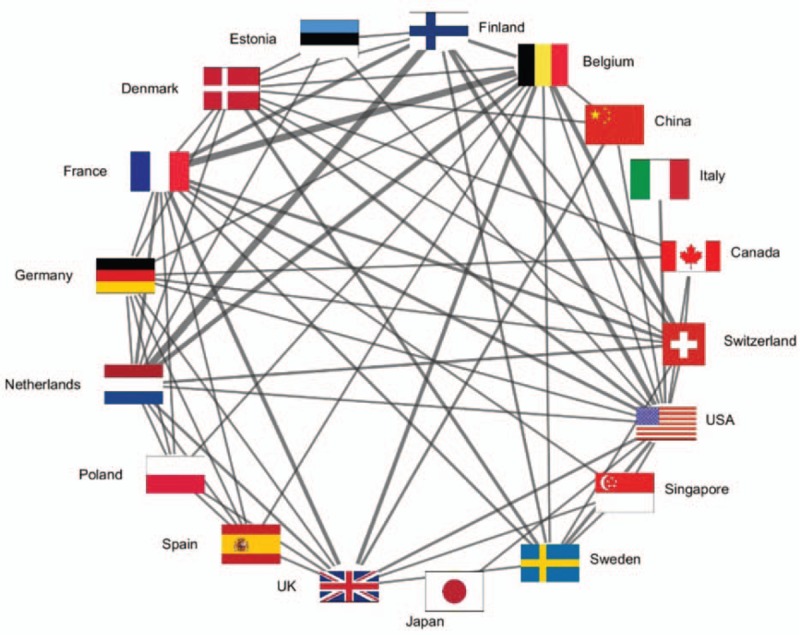
Interactions between countries of T100.
A total of 174 scientific research institutions participated in T100 researches and 49 institutions contributed more than 1 research. Institut National de la Santé et de la Recherche Médicale (INSERM) in France and Universite′ catholique de Louvain in Belgium produced 15% of the T100 articles, respectively, followed by University of Helsinki in Finland (12%), University of Copenhagen in Denmark (9%), and Wageningen University in the Netherlands (8%). Sixty-six articles had more than 1 institution and 22 articles had 5 institutions or more. Cooperation among the institutions was also documented and analyzed. Seventy-one-paired institutions cooperated twice or more in T100. The cooperation of University of Helsinki (Finland)–Wageningen University (the Netherlands) was the most frequent (n = 7), followed by University of Groningen (the Netherlands)–University of Helsinki (n = 4), Institute of Molecular Medicine (France)–Universite′ catholique de Louvain (Belgium, n = 4), Tampere University Hospital (Finland)–University of Helsinki (n = 4), and University of Turku(Finland)–University of Helsinki (n = 4). Figure 4 showed the interactions between scientific research institutions of T100.
Figure 4.
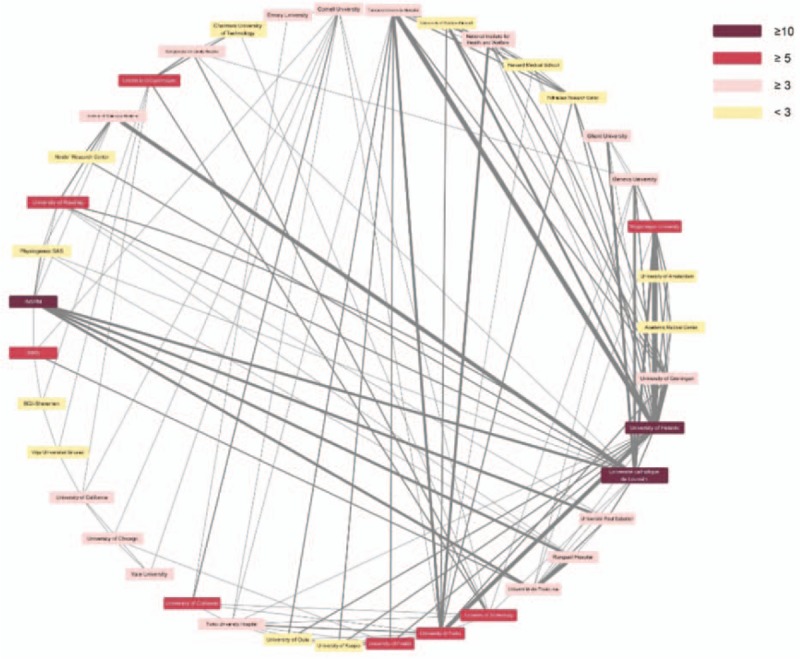
Interactions between scientific research institutions of T100.
Table 1.
Journals with more than 2 T100 articles.
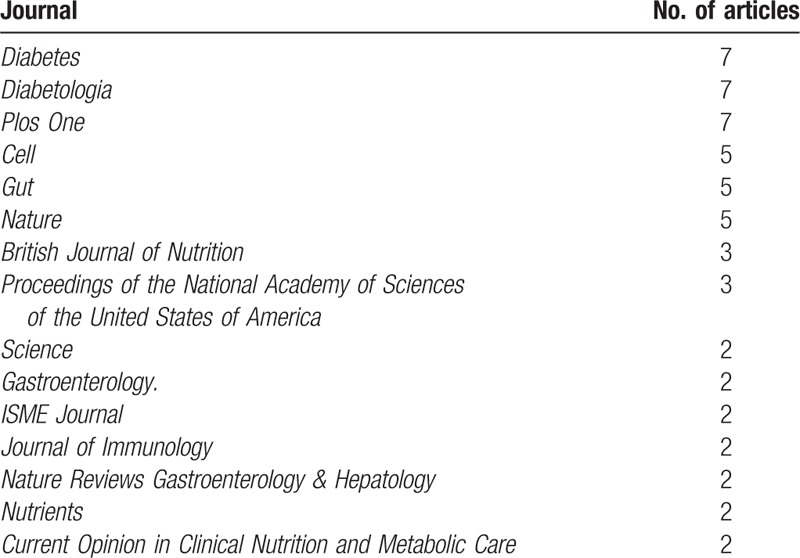
There were 14 authors who contributed more than 1 T100 articles listed as first or correspondence author. This list is led by Patrice D. Cani, who admirably authored 14 of the T100 articles, included basic science (n = 7) and expert opinion and review (n = 7). These 14 authors were listed in Table 2.
Table 2.
Authors with more than 1 T100.

Among the articles selected, there are 30 researches concentrating on T2DM & obesity, 19 researches on T1DM. In addition, 2 articles focused on metabolic syndrome and another 2 on gestational diabetes. The sequencing area of 40 articles was 16S rRNA gene, whereas 4 studies sequenced by metagenome. Eighty of the T100 articles stated their funding source. Twenty-one of them were funded by the National Institute of Health (NIH), and 15 researches were funded by FNRS/FRSM. And Juvenile Diabetes Research Foundation had supported 11 of the T100 articles.
4. Discussion
A number of research works on microbiota, the important pathogenesis mechanism of diabetes, have exponentially grown during the past decades and currently involve many other specialties.[18,19] In this study, we sought to identify the most-cited 100 articles in microbiota of diabetes, in an effort to provide insights into the development and evolvement of microbiota of diabetes over time.
As all the selected articles were published after 2007, the number of citations for the T100 articles varied from 1289 to 35, which might be fewer than those in other subspecialties.[10,11,13] However, it also reflects that scholars paid much attention on microbiota of diabetes continuously in latest years, and published many outstanding researches on top journals in the medical area that aroused widespread response. Both 2 studies published in Nature suggested that the function of the gut microbiome altered in T2DM patients no matter in Chinese or European, which linked to T2DM development.[17,20] The study published in Diabetes and Gut demonstrated that changes in gut microbiota can control inflammation, endogenous GLP-2 production, and thus led to associated metabolic disorders, which revealed the mechanism of microbiota causing the occurrence of metabolic diseases.[21,22]
The T100 were published in 59 journals. Among them, top journals published 20% of the T100, including Nature (n = 5), Science (n = 2), Cell (n = 5), and their series journals (n = 8). And another 35 articles published in the peak journal in the field of diabetes, microbiology, and gastroenterology, such as Diabetes (n = 7), Diabetologia (n = 7), Lancet Diabetes Endocrinol (n = 1), Gut (n = 5), Gastroenterology (n = 2), and ISME J (n = 2). It is well aware that outstanding articles tend to be published in journals with high impact factor (IF), and high IF journals help spread the articles’ academic influence.
Although 77% of the T100 were published in 2010–2013, several articles with high citation density published in recent 2 years, which made them accumulate relatively low total citations due to less time, such as Kostic et al[23] (2015), Shin et al[24] (2014), and Zeevi et al[25] (2015). The high interest of these researches suggested the promising academic influence in the foreseeable future. The Schubert h-index (h-index) was introduced by András Schubert in 2009.[26] It has been widely used to measure the direct and indirect citation influence of single publication. The h-index was used in our analysis of T100 to study the academic influence along with the total citations. 85% of all the T00 articles have h-index ≥10. It meant that these articles were cited by at least 10 articles which had at least 10 citations. There was a significantly strong correlation between total citations and h-index (Pearson's correlation coefficient = 0.918, P = .00).
One-third of the T100 articles were basic science (n = 32), showing the significant role of basic science to microbiota of diabetes researches in the last decade. The main body of basic science is to explore the pathogenesis and optimize the treatment.[27–30] Of all the T100, 20 articles belonged to clinical trials, including cross-sectional study (n = 12), case-control study (n = 3), RCT (n = 3), and prospective-cohort study (n = 2). The number of RCT was lower than other subspecialties due to the difficulty in carrying out. Some European countries, such as Belgium and France, started to research early and have formed the mature scientific research institutions. With these institutions as the core, scholars began to carry out the clinical study that radiating to the national and international hospitals.[20,23,31] Scholars in China and USA also performed several cross-sectional studies and tried to identify the gut microbial markers that might distinguish between DM and healthy people.[17,32,33] In addition, review (n = 29) and expert opinion (n = 19) occupied lots of T100 as well, which was more than other subspecialties. Especially some top professional experts expressed their views in depth, which played a very important role in guiding this uprising research field.
As for the study contents apart from review and expert opinion, there were 30 articles focused on the treatment, which showed the importance in microbiota regulation. Among the methods of microbiota regulation, modifying of intestinal microbiota (n = 10), prebiotic (n = 8), and antibiotic (n = 4) were highly recommended. Other methods included oral antidiabetic drug (OHA), RYGB, and complementary & alternative therapy, such as herbal medicine.[34] Besides, eating habit has a great impact on regulating microbiota.[25,35–37] The explorations of pathogenesis (n = 11) and gut microbial markers in DM (n = 11) were important branches of research as well.
Most of T100 articles were contributed by authors and affiliations located in USA and European countries. Those authors who contributed more than 1 article in T100 were mainly from these countries. Almost half of T100 articles were supported by NIH grant (n = 21), FNRS/FRSM (n = 15), and Juvenile Diabetes Research Foundation (n = 11), and European Union Seventh Framework Programme (FP7) funded several researches in T100 as well. Such circumstances indicate that USA and Europe are the leading areas in this field, and contribute enormously in exploring DM treatment by regulating microbiota. A total of 6 studies were completed in 5 countries or more, and 5 studies were completed in 10 institutions or more. The communications among European countries were very frequent, such as Belgium, France, Finland, the Netherlands, Denmark, and Sweden. They worked together to complete the clinical studies and explore the mechanisms of metabolic disorders as mentioned above.[17,23,38,39] The important scientific research institutions would be involved, such as Universite′ catholique de Louvain in Belgium (n = 15) and INSERM in France (n = 15), while the most influential experts in this field worked for these institutions, such as Patrice D. Cani (Belgium, n = 15), Nathalie M. Delzenne (Belgium, n = 7) and Re′my Burcelin (France, n = 6). Although the voice from Asia was relatively low, some countries, such as China, Japan, and Korea, contributed several researches in T100. To know that the prevalence and the treatment of diabetes are not so exceedingly satisfying in developing countries with larger population,[40,41] and the condition to carry out clinical research on microbiota of diabetes seems not to be mature in these countries, we hope that the study related would produce excellent and influential results and benefit the DM treatment in these countries and worldwide.
Changes in lifestyle and increase in fat-enriched diet are important contributors to the worldwide DM and obesity epidemic, and the microbial inhabitants of the gut could have an influence on metabolic processes; thus, the pathogenesis and treatment of T2DM associated with microbiota have been extensively studied (n = 30). However, the relationship between microbiota and T1DM cannot be ignored. The study published in Nature showed that the incidence of T1DM can be affected by the microbial environment, and the interaction of the intestinal microbes with the innate immune system is a critical epigenetic factor modifying T1DM predisposition.[28] Besides, the sequencing area of microbiota was mainly at 16S rRNA gene in past decade (n = 40). With the maturity of the method and cost reduction, the application of metagenome would be widespread in future.
There were some limitations in this study. Our results were influenced by our choice of search database, search terms, and inclusion/exclusion criteria, and we did not include the citation count from other database source. There may be many factors that affect the total citations an article receives, and the academic influence of an article could not be reflected by citations alone. Citation is logically dependent on its publication year because citations accumulate over time; older articles are likely to be cited more than recent articles. As microbiota of diabetes becomes a new focus in past decade, some articles with high quality might have been missed in our analysis due to a short publish time.[42] Moreover, some of the authors may have cited articles from the journal in which they hoped to publish their researches. Hence, the academic influence should be comprehensively judged with other parameters, such as the h-index and citation density. Despite these limitations, we provided insights into the new focus about the characteristics on microbiota of diabetes in the past decade.
5. Conclusion
In this study, we analyzed the 100 most cited articles focused on microbiota of diabetes via bibliometric approaches. All the selected articles were published after 2007. Basic science and review and expert opinion were the majority of the T100 articles, which aided the development and optimization of pathogenesis and treating diabetes. USA and European countries are the leading countries in microbiota of diabetes research field. This report provides insights into developments and characteristics of the most cited articles in the field on microbiota of diabetes.
Footnotes
Abbreviations: DM = diabetes mellitus, RCT = randomized clinical trial, TCM = traditional Chinese medicine, INSERM = Institut National de la Santé et de la Recherche Médicale, OHA = oral antidiabetic drug, RYGB = Roux-en-Y gastric bypass, SCFA = short-chain fatty acids.
Funding: This study was supported by the National Natural Science Foundation of China (No. 81430097).
The authors have no conflicts of interest to disclose.
References
- [1].Ogurtsova K, da Rocha Fernandes JD, Huang Y, et al. IDF Diabetes Atlas: Global estimates for the prevalence of diabetes for 2015 and 2040. Diabetes Res Clin Pract 2017;128:40–50. [DOI] [PubMed] [Google Scholar]
- [2].Yang W, Lu J, Weng J, et al. Prevalence of diabetes among men and women in China. N Engl J Med 2010;362:1090–101. [DOI] [PubMed] [Google Scholar]
- [3].Laiteerapong N, John PM, Nathan AG, et al. Public health implications of recommendations to individualize glycemic targets in adults with diabetes. Diabetes Care 2013;36:84–9. [DOI] [PMC free article] [PubMed] [Google Scholar]
- [4].Menke A, Casagrande S, Geiss L, et al. Prevalence of and trends in diabetes among adults in the United States, 1988–2012. JAMA 2015;314:1021–9. [DOI] [PubMed] [Google Scholar]
- [5].Ley RE, Bäckhed F, Turnbaugh P, et al. Obesity alters gut microbial ecology. Proc Natl Acad Sci U S A 2005;102:11070–5. [DOI] [PMC free article] [PubMed] [Google Scholar]
- [6].Bäckhed F1, Ding H, Wang T, et al. The gut microbiota as an environmental factor that regulates fat storage. Proc Natl Acad Sci U S A 2004;101:15718–23. [DOI] [PMC free article] [PubMed] [Google Scholar]
- [7].Roberfroid M, Gibson GR, Hoyles L, et al. Prebiotic effects: metabolic and health benefits. Br J Nutr 2010;104:S1–63. [DOI] [PubMed] [Google Scholar]
- [8].Vrieze A, Van Nood E, Holleman F, et al. Transfer of intestinal microbiota from lean donors increases insulin sensitivity in individuals with metabolic syndrome. Gastroenterology 2012;143:913–6. [DOI] [PubMed] [Google Scholar]
- [9].Lutman M. Bibliometric analysis as a measure of scientific output. Br J Audiol 1992;26:323–4. [DOI] [PubMed] [Google Scholar]
- [10].Oh YS, Galis ZS. Anatomy of success: the top 100 cited scientific reports focused on hypertension research. Hypertension 2014;63:641–7. [DOI] [PMC free article] [PubMed] [Google Scholar]
- [11].Loomes DE, van Zanten SV. Bibliometrics of the top 100 clinical articles in digestive disease. Gastroenterology 2013;144:673–6. [DOI] [PubMed] [Google Scholar]
- [12].Zhao X, Guo L, Lin Y, et al. The top 100 most cited scientific reports focused on diabetes. Acta Diabetol 2016;53:13–26. [DOI] [PubMed] [Google Scholar]
- [13].Seriwala HM, Khan MS, Shuaib W, et al. Bibliometric analysis of the top 50 cited respiratory articles. Expert Rev Respir Med 2015;9:817–24. [DOI] [PubMed] [Google Scholar]
- [14].Shuaib W, Costa JL. Anatomy of success: 100 most cited articles in diabetes research. Ther Adv Endocrinol Metab 2015;6:163–73. [DOI] [PMC free article] [PubMed] [Google Scholar]
- [15].Geaney F, Scutaru C, Kelly C, et al. Type 2 diabetes research yield, 1951–2012: bibliometrics analysis and densityeEqualizing mapping. PLoS One 2015;10:e0133009. [DOI] [PMC free article] [PubMed] [Google Scholar]
- [16].Cani PD, Amar J, Iglesias MA, et al. Metabolic endotoxemia initiates obesity and insulin resistance. Diabetes 2007;56:1761–72. [DOI] [PubMed] [Google Scholar]
- [17].Qin J, Li Y, Cai Z, et al. A metagenome-wide association study of gut microbiota in type 2 diabetes. Nature 2012;490:55–60. [DOI] [PubMed] [Google Scholar]
- [18].Li J, Lin S, Vanhoutte PM, et al. Akkermansia muciniphila protects against atherosclerosis by preventing metabolic endotoxemia-induced inflammation in apoe-/- mice. Circulation 2016;133:2434–46. [DOI] [PubMed] [Google Scholar]
- [19].Li D, Achkar JP, Haritunians T, et al. A pleiotropic missense variant in SLC39A8 is associated with Crohn's disease and human gut microbiome composition. Gastroenterology 2016;151:724–32. [DOI] [PMC free article] [PubMed] [Google Scholar]
- [20].Karlsson FH, Tremaroli V, Nookaew I, et al. Gut metagenome in European women with normal, impaired and diabetic glucose control. Nature 2013;498:99–103. [DOI] [PubMed] [Google Scholar]
- [21].Cani PD, Bibiloni R, Knauf C, et al. Changes in gut microbiota control metabolic endotoxemia-induced inflammation in high-fat diet-induced obesity and diabetes in mice. Diabetes 2008;57:1470–81. [DOI] [PubMed] [Google Scholar]
- [22].Cani PD, Possemiers S, Van de Wiele T, et al. Changes in gut microbiota control inflammation in obese mice through a mechanism involving GLP-2-driven improvement of gut permeability. Gut 2009;58:1091–103. [DOI] [PMC free article] [PubMed] [Google Scholar]
- [23].Kostic AD, Gevers D, Siljander H, et al. The dynamics of the human infant gut microbiome in development and in progression toward type 1 diabetes. Cell Host Microbe 2015;17:260–73. [DOI] [PMC free article] [PubMed] [Google Scholar]
- [24].Shin NR, Lee JC, Lee HY, et al. An increase in the Akkermansia spp. Population induced by metformin treatment improves glucose homeostasis in diet-induced obese mice. Gut 2014;63:727–35. [DOI] [PubMed] [Google Scholar]
- [25].Zeevi D, Korem T, Zmora N, et al. Personalized nutrition by prediction of glycemic responses. Cell 2015;163:1079–94. [DOI] [PubMed] [Google Scholar]
- [26].Schubert A. Using the h-index for assessing single publications. Scientometrics 2009;78:559–65. [Google Scholar]
- [27].Vijay-Kumar M, Aitken JD, Carvalho FA, et al. Metabolic syndrome and altered gut microbiota in mice lacking Toll-like receptor 5. Science 2010;328:228–31. [DOI] [PMC free article] [PubMed] [Google Scholar]
- [28].Wen L, Ley RE, Volchkov PY, et al. Innate immunity and intestinal microbiota in the development of Type 1 diabetes. Nature 2008;455:1109–13. [DOI] [PMC free article] [PubMed] [Google Scholar]
- [29].Cani PD, Neyrinck AM, Fava F, et al. Selective increases of bifidobacteria in gut microflora improve high-fat-diet-induced diabetes in mice through a mechanism associated with endotoxaemia. Diabetologia 2007;50:2374–83. [DOI] [PubMed] [Google Scholar]
- [30].Cabreiro F, Au C, Leung KY, et al. Metformin retards aging in C. elegans by altering microbial folate and methionine metabolism. Cell 2013;153:228–39. [DOI] [PMC free article] [PubMed] [Google Scholar]
- [31].Dewulf EM, Cani PD, Claus SP, et al. Insight into the prebiotic concept: lessons from an exploratory, double blind intervention study with inulin-type fructans in obese women. Gut 2013;62:1112–21. [DOI] [PMC free article] [PubMed] [Google Scholar]
- [32].Koren O, Goodrich JK, Cullender TC, et al. Host remodeling of the gut microbiome and metabolic changes during pregnancy. Cell 2012;150:470–80. [DOI] [PMC free article] [PubMed] [Google Scholar]
- [33].Giongo A, Gano KA, Crabb DB, et al. Toward defining the autoimmune microbiome for type 1 diabetes. ISME J 2011;5:82–91. [DOI] [PMC free article] [PubMed] [Google Scholar]
- [34].Zhang X, Zhao Y, Zhang M, et al. Structural changes of gut microbiota during berberine-mediated prevention of obesity and insulin resistance in high-fat diet-fed rats. PLoS One 2012;7:e42529. [DOI] [PMC free article] [PubMed] [Google Scholar]
- [35].Serino M, Luche E, Gres S, et al. Metabolic adaptation to a high-fat diet is associated with a change in the gut microbiota. Gut 2012;61:543–53. [DOI] [PMC free article] [PubMed] [Google Scholar]
- [36].Neyrinck AM, Possemiers S, Verstraete W, et al. Dietary modulation of clostridial cluster XIVa gut bacteria (Roseburia spp.) by chitin-glucan fiber improves host metabolic alterations induced by high-fat diet in mice. J Nutr Biochem 2012;23:51–9. [DOI] [PubMed] [Google Scholar]
- [37].Axling U, Olsson C, Xu J, et al. Green tea powder and Lactobacillus plantarum affect gut microbiota, lipid metabolism and inflammation in high-fat fed C57BL/6J mice. Nutr Metab (Lond) 2012;9:105. [DOI] [PMC free article] [PubMed] [Google Scholar]
- [38].Markle JG, Frank DN, Mortin-Toth S, et al. Sex differences in the gut microbiome drive hormone-dependent regulation of autoimmunity. Science 2013;339:1084–8. [DOI] [PubMed] [Google Scholar]
- [39].Geurts L, Lazarevic V, Derrien M, et al. Altered gut microbiota and endocannabinoid system tone in obese and diabetic leptin-resistant mice: impact on apelin regulation in adipose tissue. Front Microbiol 2011;2:149. [DOI] [PMC free article] [PubMed] [Google Scholar]
- [40].Anjana RM, Pradeepa R, Deepa M, et al. Prevalence of diabetes and prediabetes (impaired fasting glucose and/or impaired glucose tolerance) in urban and rural India: phase I results of the Indian Council of Medical Research-INdia DIABetes (ICMR-INDIAB) study. Diabetologia 2011;54:3022–7. [DOI] [PubMed] [Google Scholar]
- [41].Tharkar S, Devarajan A, Kumpatla S, et al. The socioeconomics of diabetes from a developing country: a population based cost of illness study. Diabetes Res Clin Pract 2010;89:334–40. [DOI] [PubMed] [Google Scholar]
- [42].Forslund K, Hildebrand F, Nielsen T, et al. Disentangling type 2 diabetes and metformin treatment signatures in the human gut microbiota. Nature 2015;528:262–6. [DOI] [PMC free article] [PubMed] [Google Scholar]


